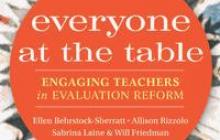Principles of Sound Teacher Engagement
Renewing the conversation on teachers’ role in educational reform, the U.S. Department of Education’s new Excellent Educators for All Initiative requires states to consult with teachers when creating new plans to ensure students have equitable access to educators. In the same vein, the Department also recently launched a website, Commit to Lead, to encourage educators to share ideas for teacher leadership. As my colleagues and I noted in Everyone at the Table, teachers’ voices are left out of conversations over major policy changes. Here, adapted from the book, are core principles for collaborative problem-solving for sustainable policies.
Begin by Listening
To understand teachers’ interests and concerns, listen before talking. Understanding how teachers interpret policy language will lead to more meaningful engagement by uncovering potential stumbling blocks or opportunities for common ground, or both.
For example, researchers from Public Agenda found in conversations with college professors that the term “productivity” was most likely to trigger dissent. For the leaders of the colleges, “productivity” meant helping more students earn a credential more efficiently at a lower cost for students and taxpayers. For faculty members, “productivity” conjured up images of assembly lines. Conversations between policymakers and faculty improved when measures of productivity—such as “reducing student debt”—were used instead of freighted terms.
Recognize There Are No Easy Answers
The conversation starters we called Choicework in Everyone at the Table, reflect the fact that there’s no magic bullet. Instead, Choicework lays out three or four potential approaches to a problem, and the need for tradeoffs with any approach is stressed. Considering choices side by side allows people to look at different ideas for addressing an issue and helps them break out of either/or thinking.
Perfect solutions to complex policy problems are rare, but Choicework invites a more practical frame of mind and can move people beyond polarizing, zero-sum arguments and toward productive (yes, that word again!), realistic, solution-oriented dialogue. With the context Choicework presents in mind, participants can focus on the issues and avoid repetitive venting. See examples of Choicework discussion starters in the book or at Public Agenda’s website.
Moderators Are Skillful Hosts
Moderators are like skillful hosts who keep the party lively without themselves becoming the center of attention.
Productive engagement often hinges on facilitation. An effective moderator is critical to a productive conversation on tough issues. There’s always a chance these types of conversations will disintegrate into a session for gossiping, venting, blaming, or arguing, particularly if sensitive topics such as equitable teacher distribution are broached.
Moderators are like skillful hosts who keep the party lively without themselves becoming the center of attention. They keep their biases under wraps and don’t overwhelm or redirect the natural flow of conversation. Moderators should be neutral, unbiased, and patient. Instead of leading anyone toward a preset or “correct” answer, they should keep conversations on the path to solutions. For these reasons, moderators need to be chosen and trained with care.
Dialogue, Not Debate
Engaging teachers to promote evolution of judgment and collaborative problem-solving requires dialogue. Unlike debate or negotiation, dialogue is not intended to settle a matter, win an argument, or vanquish an opponent. Instead, through active empathetic listening, dialogue helps people uncover and confront assumptions, broaden perspectives, and find common ground.
Unlike debate or negotiation, dialogue is not intended to settle a matter, win an argument or vanquish an opponent.
Unfortunately, examples of polarized debate outnumber examples of what’s needed. But two ways to distinguish dialogue from discussion can help. According to The Magic of Dialogue: Transforming Conflict Into Cooperation, there can be no dialogue without equality and trust as a foundation. Everyone—rookies and veterans, department heads and union reps, art teachers and math teachers—should participate on equal footing. In genuine dialogue, no one pulls rank, twists anyone’s arm, hints at sanctions for specific opinions, or uses coercive influence.
Also, this useful book counsels, learn to recognize which differences are trivial. Differences in opinion are often exaggerated, so don’t assume those who don’t support your ideas object to them outright. Often, all parties have many values in common in a complex or contentious issue, but simply rank them differently. With teacher evaluation, for example, most people agree on certain underlying values: evaluations should be comprehensive and consistent, or evaluations should be fair and flexible. Few would argue against these values, but people may disagree on the principles’ relative importance.
Disagreements are natural—a healthy part of democratic problem-solving—but they should be productive. When we examine our assumptions instead of fighting blindly for our convictions, we are far less likely to misunderstand one another or to make errors in judgment, and we are better able to view one another as human beings rather than as ideologues.
Ellen Sherratt is a senior research and policy analyst at AIR. She works with the Center on Great Teachers and Leaders at AIR, an affiliate of the U.S. Department of Education's Commit to Lead website.
